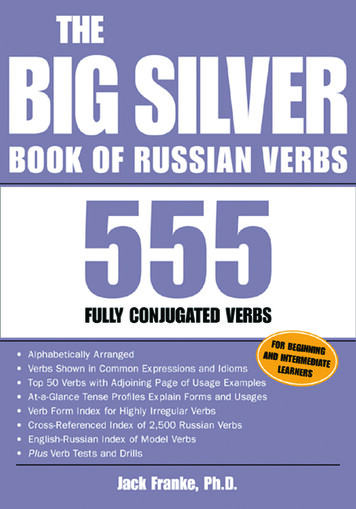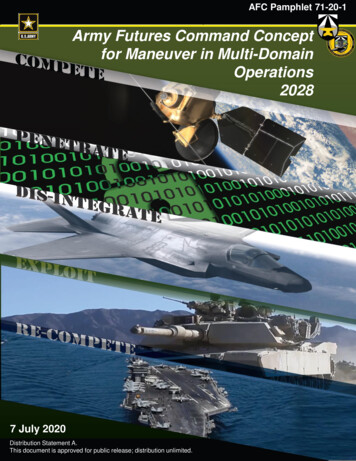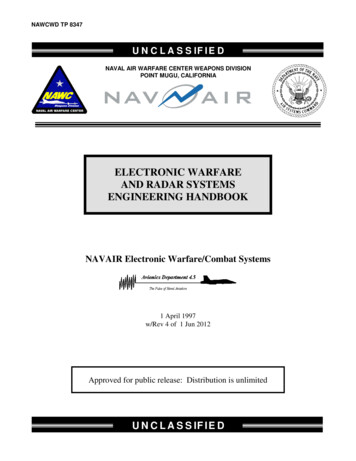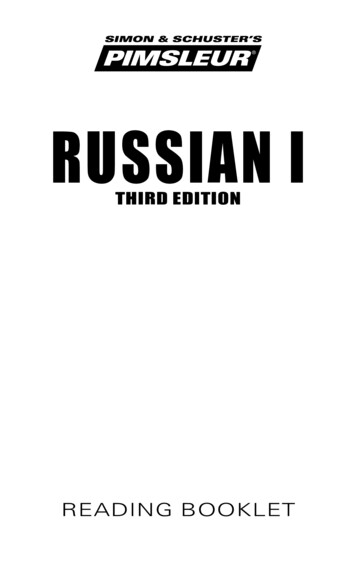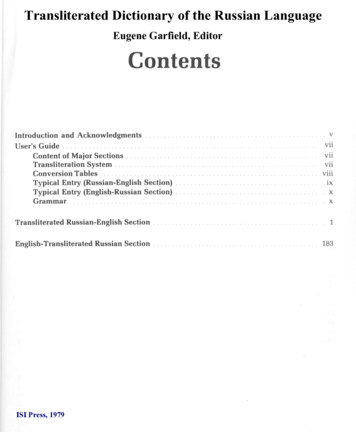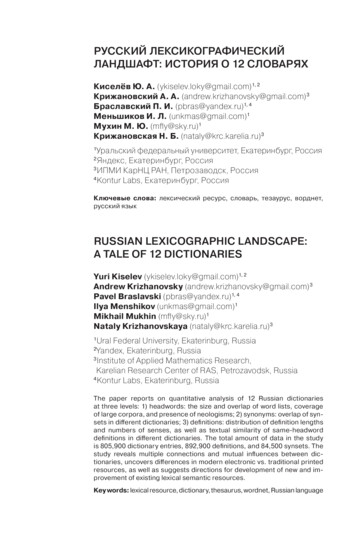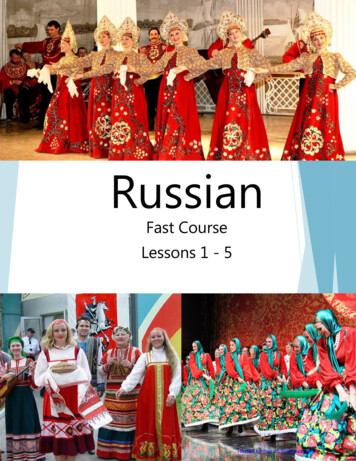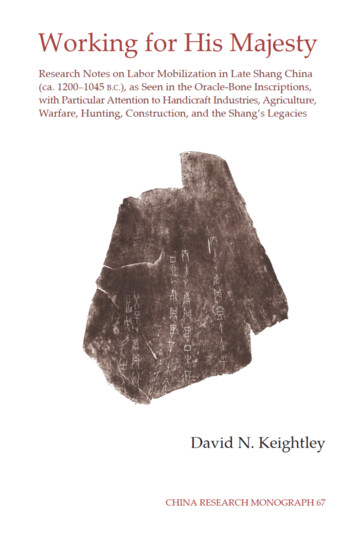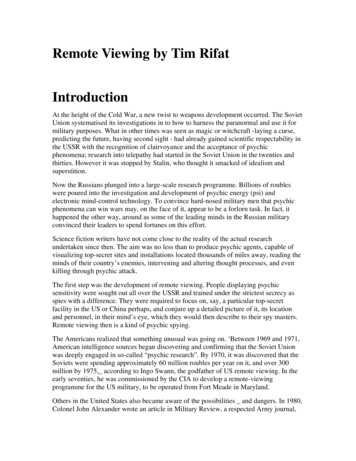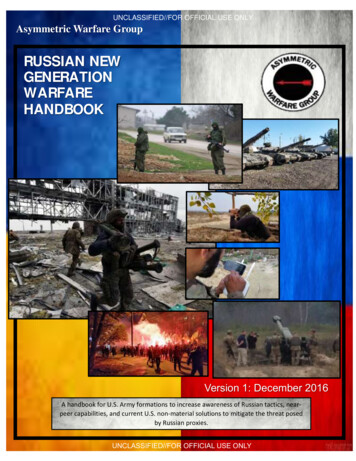
Transcription
UNCLASSIFIED//FOR OFFICIAL USE ONLYUNCLASSIFIED//FOR OFFICIAL USE ONLYAsymmetric Warfare Group234205RUSSIAN NEWGENERATIONWARFAREHANDBOOKVersion 1: December 2016A handbook for U.S. Army formations to increase awareness of Russian tactics, nearpeer capabilities, and current U.S. non-material solutions to mitigate the threat posedby Russian proxies.UNCLASSIFIED//FOR OFFICIAL USE ONLYUNCLASSIFIED//FOR OFFICIAL USE ONLY0
UNCLASSIFIED//FOR OFFICIAL USE ONLYDISCLAIMER: The information contained herein is not current U.S. doctrine or policy and is not meant to supersededoctrine, commander’s guidance, or established unit standard operating procedures. Examine and use theinformation in light of your mission, the operational environment, the Law of Armed Conflict, and other situationalfactors. This document does not constitute the provision of additional information or the approval of additionalinformation upon request.DISTRIBUTION STATEMENT C: Distribution authorized to US Government agencies and their contractors;operations security; 01Nov16. Other requests for this document shall be referred to Asymmetric Warfare Group, FortMeade, MD 20755.EXEMPTION NOTICE: This document contains information that may be exempt from mandatory disclosure under theFreedom of Information Act.COPYRIGHT NOTICE: This document may contain copyrighted information.iUNCLASSIFIED//FOR OFFICIAL USE ONLY
UNCLASSIFIED//FOR OFFICIAL USE ONLY(U) Table of ContentsFOREWORD.iiiPURPOSE.ivNEW ORGANIZATIONAL STRUCTURE .1RUSSIAN ORGANIZATION AND THREAT TACTICS, TECHNIQUES, ANDPROCEDURES .2U.S. STRATEGIES TO DEFEAT AND MITIGATE RUSSIAN TTPS . . 29U.S. TRAINING RECOMMENDATIONS . 35APPENDIX 1 – COUNTER-TARGET ACQUISITION BATTLE DRILL. .52APPENDIX 2 – SOURCES . . 58ACKNOWLEDGMENTS . 61iiUNCLASSIFIED//FOR OFFICIAL USE ONLY
UNCLASSIFIED//FOR OFFICIAL USE ONLY(U) FOREWORD(U) As the American Army fought in Iraq and Afghanistan, it became the best tactical levelcounter insurgency force of the modern era. America’s enemies, however, did not rest. Russia observedthe transformation of the American Army and began a transformation of their own. This new militarybarely resembles its former Soviet self. Wielding a sophisticated blend of Unmanned Aircraft Systems(UAS), electronic warfare (EW) jamming equipment, and long range rocket artillery, it took the Sovietmodel out of the 1980s and into the 21st Century.(U) Ukraine’s 2014 Euromaidan Revolution overthrew a corrupt Russian supported presidentand threatened to place a pro-European government in power on the very outskirts of the RussianFederation. In March 2014, Russia occupied Ukraine’s Crimea with SPETsNAZ units in a virtuallybloodless operation. SPETsNAZ then infiltrated into the Donbas region, fomenting unrest and sparking apro-Russian insurgency.(U) Over the next few months, the Ukrainian military and volunteer militia fought back rathersuccessfully. They pushed the separatists back to the very border with Russia. Then everything changed.Russian regular troops with heavy equipment attacked across their border and fought a series ofencirclement battles resulting in hundreds of Ukrainian troops killed and the Ukrainian Anti-TerrorOperation teetering on the brink of defeat.(U) How do we combat this enemy? America has not encountered this type of conflict for nearlya generation and needs to transform to fight and win in complex maneuver warfare. Several factorscontribute to potential challenges U.S. formations may face in such a conflict: It has been several yearssince we deployed large numbers of troops in combat in Iraq or Afghanistan. Our junior leaders, bothofficers and enlisted, have less and less combat experience. Our equipment has been designed tocombat an insurgency, not an enemy with potential overmatch. How do we protect our troops fromunmanned aerial vehicles (UAVs), communications and GPS jamming, and layered air defense networks?(U) This handbook attempts to examine the tactics used by Russia in Ukraine as the militarycomponent of their New Generation Warfare doctrine. We will attempt to describe their capabilities andapplications of combat power. Finally, this handbook will present recommendations for U.S. Battalionsand Brigade Combat Teams to counter these Russian methods of war. The war in Ukraine is still ongoing.The Russian Forces are still involved in Syria and continue to improve from their successes and shortfalls.We, as American Soldiers, must do the same. As the saying goes, “Only fools learn from their mistakes.The wise man learns from the mistakes of others.”Asymmetric Warfare GroupiiiUNCLASSIFIED//FOR OFFICIAL USE ONLY
UNCLASSIFIED//FOR OFFICIAL USE ONLY(U) PURPOSE(U) Beginning in February of 2014, Russian Forces occupied and annexed the Crimean peninsulaleading to the near dissolution of Ukraine’s Navy. Separatist forces, enabled by Russian military support,began a conflict in Eastern Ukraine resulting in large amounts of the country turning into a war zone.Over twenty four months later, Ukraine finds itself in a situation that has all the makings of a frozenconflict. The Minsk II ceasefire agreement has stymied offensive operations on the separatist side andany offensive taken by the Ukrainian Armed Forces (UAF) will embolden Russia and provide “probablecause” for recourse and reinvigorated separatist support.(U) As the global community became more aware of the circumstances, western nationsprovided assistance to the UAF in order to accomplish three things: modernize the UAF doctrine,provide necessary equipment to level the playing field, and build Ukrainian institutional capacity to helptrain their forces in western military standards. The training effort is well under way with manycountries providing assistance in areas such as medical, logistics, and staff training; as well as trainingentire battalions in more modernized western tactics. While the training and assistance efforts areprogressing, U.S Forces should now begin contemplating how our formations should best preparethemselves for the threats that the Ukrainian Armed Forces (UAF) face and identify gaps within our owndoctrine.(U) The majority of this handbook will be centered on the Russian threat and how Russian LedSeparatist Forces (RLSF) conducted operations in Eastern Ukraine since March of 2014. Leaders at alllevels are starting to realize that U.S. engagements during the Global War on Terrorism have created aforce less than prepared to face a peer/near-peer conflict. The RLSF’s application and layering of theirsystems increases accuracy and lethality while simultaneously degrading their opponent’s capabilities.This has led to the U.S. Army taking a closer look at our force and identifying numerous capability gapswithin training and technology that formerly ensured U.S. overmatch.(U) Certain things have been bred into today’s Soldier and dictate how we see the battlefield.We own the night, the air, have qualitative numerical superiority, our technology is the best in the worldetc. The assumption that we will have these capabilities is inherent to every planning process the Armyconducts. Unfortunately, these are not assumptions we can continue to safely make for our Soldiers inpreparing for future conflicts. Training center rotations must be focused on exposing formations to newthreats and prioritize learning over winning the rotation. This will bring back the basic skills our Armyfocused on for years and before we lose the existing combat expertise within our force.(U) The overarching purpose of this handbook will be to identify training priorities that are notcurrently a focus area within our ranks. By providing commanders and senior enlisted leaders withpossible training gaps within our force, leaders will begin thinking about the threat as it exists today inEastern Europe. Our focus at the operational and tactical levels should not be on the “newest kit,” butwhat we have to do in order to achieve success without it. The current era of a budget constrained Armymeans that we must outthink our opponent and capitalize on his weaknesses. This handbook is thebeginning to provide the necessary insights to inform our current force while simultaneously creatingbest practices that units can share and expand upon.ivUNCLASSIFIED//FOR OFFICIAL USE ONLY
UNCLASSIFIED//FOR OFFICIAL USE ONLYUNCLASSIFIED//FOR OFFICIAL USE ONLY(U) Figure 1: Russian Forces Modernization InfographicChapter 1:1
UNCLASSIFIED//FOR OFFICIAL USE ONLYChapter 1:(U) Russian Organization and Threat Tactics, Techniques,and Procedures(U) Understanding the Environment(U) Since the collapse of the Soviet Union, a number of conflicts and reforms have shaped theRussian military into what it is today. Russia has observed the American lessons learned in Iraq andAfghanistan, as well as their own from the 2008 invasion of Georgia, and applied these to thedevelopment of their forces. Several key changes have been implemented under Vladimir Putin (thecurrent President of the Russian Federation) in the previous decade. These include a rapidmodernization and increased complexity of equipment, attempts to professionalize military education,and a restructuring of the military to a more expeditionary model in order to project Russian influenceinto Europe, the Middle East, and Asia.(U) The current state of Russia’s military is a modernizing force with an increasinglytechnological character. It aligns its units and capabilities to satisfy a mission requirement. Russia’s useof Battalion Tactical Groups (BTGs) gives Russia the capability to project its forces regionally with highspeed and intensity to achieve desired tactical, operational, and strategic goals1. This focus on smallerexpeditionary operations within Russia's regional sphere of influence means a more agile and modularforce than during the Cold War and even during the Chechnya conflict in the 1990’s. This was noticeablyon display in their seizure of Crimea and the current conflict in Eastern Ukraine.(U) Russia has one of the highest military spending budgets in the world. While this is nowherenear the same real-dollar amount as the United States, Russia’s military development and investmenthas resulted in a significant increase in technical capabilities and personnel reformations. To make up forinadequate individual soldier training, the Russian military relies mainly on either motorized ormechanized units. This allows them to compensate for their lower skill in maneuver warfare withmassive firepower. Some current and developing aspects of Russian military vehicles focus oneliminating human components and replacing them with a mechanism, such as the autoloader on tanksand Boyevaya Mashina Pekhoty (Infantry Fighting Vehicle/BMPs. This is cheaper than training, housing,and paying soldiers, which allows the Russian military to invest more in firepower. However, Russia hasmade significant strides to modernize its military force and adapt it to use more sophisticatedtechnologies. This involves significant investment into soldiers and a more professional soldier force2.(U) Russia has tried to professionalize its force by investing in contracted soldiers (volunteers).The majority of Russia’s military consists of conscripts drafted for 1 year service periods. By the timethese conscripts receive training and are sent to a unit, they may only have 6-8 months left before beingdemobilized. This severely limits the quality of the average Russian soldier and unit as a whole.Professional soldiers inherently have more experience and training than the 1 year conscripts thatcirculate out of the formations every 6 months. Professionalization efforts have been a large focus areafor Russia for years, but are still a significant challenge.1Grau, L. L. (1989). The Soviet Combined Arms Battalion - Reorganization for Tactical Flexibility. Ft. Levenworth, Kansas: DTIC.2Thornton, R. (2011). Military Modernization and the Russian Ground Forces. Carlisle, Pennsylvania: U.S. Army War College Strategic Studies Institute.2UNCLASSIFIED//FOR OFFICIAL USE ONLY
UNCLASSIFIED//FOR OFFICIAL USE ONLY(U) The primary maneuver element favored by the Russian military is the battalion, organized asa Battalion Tactical Group. The BTG is significant because the Tactical Group is built around its mission. Itcan be augmented with any enabler to facilitate its mission. BTGs are usually used as reinforcements instrategically vital engagements and held in reserve until they are needed.(U) Russian Ground forces have updated their military doctrine to reflect these numerouschanges in their organization, equipment, and tactics. Their new doctrine views the military as part of abroader national whole of governmentapproach to warfare. This “Gerasimov(U) Gerasimov Doctrine“The doctrine posits that theDoctrine,” named after the current Russianrules of war have changed, thatChief of the General Staff, is outside the scopethere is a “blurring of the linesof this work. However, at the tactical levelbetween war and peace,” andthat “nonmilitary means ofRussia still refers to doctrine as an “ustav,” orachieving military and strategicmandate, which informs commanders andgoals has grown and, in manytactical decision makers on how to conduct theircases, exceeded the power ofoperations. The most recent editions haveweapons in their effectiveness.”Douglas Farah, The CIPHER Briefbegun to include sketches and proposedsolutions to tactical problems. This approach to(U) Figure 2: General of the Army Valeri Gerasimovdoctrine as a science, rather than an art, is aholdover from Soviet doctrinal methodologyand part of the Russian military culture3.(U) ASYMMETRIC WARFARE(U) Over the past 15 plus years, U.S. formations have become familiar with the term“asymmetric warfare or tactics.” Because of the nature of Iraq and Afghanistan, many have come to seethis as a new approach to warfare. Or as a strategy between two opponents of drastically differentstrengths, usually used by the weaker opponent i.e. the U.S. and the Taliban or Al Qaida, with the U.S.being technologically and financially superior to both of its opponents.(U) An apt description of Asymmetric approaches and thinking appeared in Dr. Rod Thornton’spublication “Asymmetric Warfare: Threat and Response in the Twenty First Century”:“The September 11 attack was perhaps the supreme example of what has come to be known as‘asymmetric warfare’. Thisphrase is one that is now(U) Dr. Rod ThorntonDr.RodThorntonisa prior service British Army infantrydominating the lexicon ofOfficer with service in Germany, Cyprus, Northern Irelandmilitary and security forcesand Bosnia. He studied Russian and Serbo-Croat and thenaround the developedtook two masters degrees. His PhD was from the Universityof Birmingham and involved a comparison of British,world. At its simplest,Russian and US peace support operations. He has severalasymmetric warfare ispublication on Asymmetric and Counter Insurgencyviolent action undertakenWarfare and Easter Europe.by the ‘have-nots’ against(U) Figure 3: Dr. Rod Thorntonthe ‘haves’ whereby thehave-nots, by the state orsub-state actors, seek to generate profound effects – at all levels of warfare (however defined), from the3Ministry of Defense, Russian Federation. (2005). Battle Directives on the Preparation and Conduct of a Combined Armes Battle, Section 3: Squad, Platoon, andTank Section. Moscow: Military Publication.3UNCLASSIFIED//FOR OFFICIAL USE ONLY
UNCLASSIFIED//FOR OFFICIAL USE ONLYtactical to strategic – by employing their own specific relative advantages against the vulnerabilities ofmuch stronger opponents. Often this will mean that the weak will use the methods that lie outside the‘norms’ of warfare, methods that are radically different. It is the element of difference that lies at theheart of asymmetric approaches asymmetric does not mean unequal. ‘Symmetrical’ implies a mirror image; sometimes theimage can be smaller, but nonetheless a likeness exists. ‘Asymmetrical’ implies a relationship that cannot be considered alike And here it is useful to point out that asymmetric techniques can also beapplied by the stronger power4.”(U) HYBRID MANEUVER(U) During the Georgian and Ukrainian crises, Russia has developed a new approach to theiroperations, which is widely referred to as Russian New Generation Warfare (RNGW), 4th GenerationWarfare, Hybrid War, etc. In truth, Russia has been able to redefine their objective and efficiently apply(U) Hybrid Force Composition:CONV: Conventional forcesSPZ: SpetsNaz Russian version of SOF forcesAAA: Advise Assist Accompany TeamsCTR: Contracted forces from outside thearea of operations; usually sign a contractand serve along LOC forcesLOC: Militarized local populationPMC: Private Military Contractor(U) Figure 4: Hybrid Force Compositioninstruments of national power to achieve that objective. The new objective is not victory in a conflict,but regime change. Because the new objective is the change of an entire system of government, theRNGW approach can use any lever of influence in their reach to achieve this change. Not all regimechanges have to be resolved with a military option, but when a military lever is activated, it is done by,with, and through segments of the local population. The involvement of locals gives validity to militaryaction on the world stage. This makes it appear like a popular action, and produces the HybridManeuver concept that we see Russia employing in Ukraine, Syria, and elsewhere. With the currentstate of Russia’s Security Force Assistance (SFA), it is safe to assume that a Hybrid Maneuver force willbecome common with a Russian footprint.(U) During Hybrid Maneuver, the brunt of the fighting will be borne by locally organized units.These units fall under the government structure of the Russian supported regime, and have their ownmilitary organization which mirrors or mimics Russian Forces. These forces will have basic equipment,provided by Russian “Advise, Assist, and Accompany” (AAA) teams. AAA teams synchronize the Hybridforce’s operations by embedding Russian officers in the Hybrid force structure. Hybrid maneuver focuseson the local effort conducting the majority of the fighting with support from Russian conventional forceswhen the mission has strategic and operational importance.4Thornton, D. R. (2007). Asymmetric Warfare: threat and response in the twenty first century. Malden, MA: Polity Press.4UNCLASSIFIED//FOR OFFICIAL USE ONLY
UNCLASSIFIED//FOR OFFICIAL USE ONLY(U) During hybrid maneuver in Eastern Ukraine, the unit of choice has become the BTG. This is inspite of the fact that Russia has identified weaknesses in the BTG structure and are moving back towardsa divisional model. A BTG is a tailored force, centered on the mission it will be executing. This forceusually consists of three core units: infantry, armor, and artillery. It will be further augmented with otherassets such as Electronic Warfare (EW), Air Defense Artillery (ADA), and other capabilities under thebattalion commander’s control.(U) Russian Conventional Organization(U//FOUO) Figure 5: Core Tank BattalionT90 SERIESCREW: 3 PAXMAX SPEED ROAD/OFF-ROAD: 65kmh/45kmhMAIN ARMAMENT: 125 mm SmoothboreAUXILLARY WEAPONS: 7.62 mm COAX MG, 12.7mm NSVTAA MGCOMBAT LOAD: Main Gun-43rds, 7.62-2000rds, 12.7-300rdsT80 SERIESCREW: 3 PAXMAX SPEED ROAD/OFF-ROAD: 70kmh/48kmhMAIN ARMAMENT: 125 mm SmoothboreAUXILLARY WEAPONS: 7.62 mm COAX MG, 12.7mmNSVT AA MGCOMBAT LOAD: Main Gun-45rds, 7.62-1250rds, 12.7500rds5UNCLASSIFIED//FOR OFFICIAL USE ONLY
UNCLASSIFIED//FOR OFFICIAL USE ONLYT72 SERIESCREW: 3 PAXMAX SPEED ROAD/OFF-ROAD: 60kmh/45kmhMAIN ARMAMENT: 125 mm SmoothboreAUXILLARY WEAPONS: 7.62 mm COAX MG, 12.7mmNSVT AA MGCOMBAT LOAD: Main Gun-45rds, 7.62-2000rds, 12.7300rds(U//FOUO) Figure 6: Core Motorized or Mechanized Rifle BattalionBTR-90CREW: 3 PAX/7 passengersMAX SPEED ROAD/OFF-ROAD: 100kmh/50kmhMAIN ARMAMENT: 30 MM Automatic Gun, 2A42 or30 mm AGLAUXILLARY WEAPONS: 7.62 mm PKT MGCOMBAT LOAD: 30 mm-500rds/AGL-400 rds, 7.622000rds6UNCLASSIFIED//FOR OFFICIAL USE ONLY
UNCLASSIFIED//FOR OFFICIAL USE ONLYBMP-3MCREW: 3 PAX/7 passengersMAX SPEED ROAD/OFF-ROAD: 70kmh/45kmhMAIN ARMAMENT: 100 mm Rifled Gun 2A70AUXILLARY WEAPONS: 7.62 mm COAX MGCOMBAT LOAD: Main Gun-48rds, 7.62-2000rds9P162 KORNETCREW: 2-3 PAXMAX SPEED ROAD/OFF-ROAD: 70kmh/45kmhMAIN ARMAMENT: KORNET ATGMRATE OF FIRE: 3-4 missiles per minuteCOMBAT LOAD: 16 LR rounds, 10-16 HEAT, up to 6 HE(U) Anti-Access/Area Denial (A2/AD) Systems(U) The U.S. has held air superiority in conflicts dating back to the Korean War. Since enemieshave not challenged this in recent memory, U.S. forces have come to take air superiority for granted.Even during the Vietnam War, U.S. aircraft were able to provide air support and overwhelm the NorthVietnamese Air Force. Since then, the Army uses air assets for reconnaissance, transportation, firesupport, and medical evacuation. In Iraq and Afghanistan, light infantry units have come to depend onair support with extended station time and clear communication lines to the forces on the ground.(U) Compared to other militaries in the world, air power is simply the biggest enabler for U.S.forces. Because of this, Russia has gone to great lengths to develop air defense capabilities on strategic,operational, and tactical levels to deny American’s the use of this capability. Russian air defensecapabilities exist at the battalion level and higher, and can also be used task organized down to thecompany level if the situation requires it.(U) Russia’s air defense capabilities consist of direct fire, missile, and EW platforms. Strategicassets are large and cumbersome systems, but are capable of providing air defense to ground units upto a 300 kilometer radius. On the operational and tactical levels, Russian missile air defense systems areself-propelled, either on tracked or wheeled vehicles. The majority of current systems consist of singlevehicle models that have the self-contained ability to conduct target acquisition, plot a firing solution,and engage a target. At the tactical level, battalion’s possess shoulder fired missiles (MANPADS) andlight tracked or wheeled ADA systems.7UNCLASSIFIED//FOR OFFICIAL USE ONLY
(U) Figure 7: Russian ADA Protection ConceptUNCLASSIFIED//FOR OFFICIAL USE ONLY8UNCLASSIFIED//FOR OFFICIAL USE ONLY
UNCLASSIFIED//FOR OFFICIAL USE ONLY(U) MANPADS are one of the most significant threats to U.S. formations. Commanders canconduct Suppression of Enemy Air Defense (SEAD) missions to shape their AO, but the ability to conductSEAD against MANPADS carried within the line infantry formations is extremely limited. This is especiallytrue if these systems are used in urban areas around civilians as is the case in Eastern Ukraine. Withinthe first few months of the conflict in Donetsk and Lugansk, Ukraine, the Ukrainian military lost severalhelicopters, ground attack aircraft, and even a fully loaded troop transport all to MANPAD systems.(U) Russia uses a very dense network of air defense systems that overlap in layers to increasetheir protective capabilities. Gaps in coverage can also be filled by new EW systems that confuseincoming missiles, overload ordnance guidance modules, or cause premature detonation of electronicfuses. Faced with this type of air defense network, U.S. formations will, at best, be able to achieve briefor momentary air superiority to support ground troops. Russian Air Defense capabilities will alsoseverely impact aerial resupply and medical evacuation (MEDEVAC). Though Russia publicly announcesits adherence to the Geneva Convention, and recognizes internationally protected symbols, this doesnot mean that Russia’s automated Air Defense systems will recognize a MEDEVAC as an off limits target.This is similar to the case of Malaysian Airline’s Flight MH-17 which was shot down by a BUK missilesystem over Ukraine in July 2014.SA- 11 Gadfly (BuK-M1-2)PRIMARY PURPOSE: Protect task forces andinstallations from attacks of prospective high speedtactical and strategic aircraft under intensiveelectronic counter-actionDETECTION RANGE: Up to 20 kmMAX ENGAGEMENT RANGE: Up to 15 kmSIMULTANEOUSLY ENGAGED TGTS: Up to 6REACTION TIME: Up to 18 secSA-22 Greyhound (Pantsyr-S1)CREW: 3 PAXARMAMENT: 2 X 30mm Guns, 12MissilesMAX ROAD SPEED: 90 kphAIRCRAFT DETECTION RANGE: 30 kmENGAGEMENT RANGE: 3 km for Guns,20 km for Missiles9UNCLASSIFIED//FOR OFFICIAL USE ONLY
UNCLASSIFIED//FOR OFFICIAL USE ONLYSA-10 Grumble (S-300VM)PRIMARY PURPOSE: Protect task forces from mass attacks ofmed range-theatre level ballistic missiles as well as strategicand tactical aircraft.DETECTION RANGE: Up to 250 kmSIMULTANEOUSLY ENGAGED TGTS: Up to 24CONTINUOUS OPERATION TIME: Up to 48 hrsSA-21 Growler (S-400)CREW: VariableMISSILE CAPACITY: 4MAX ROAD SPEED: 70 kphMISSILE RANGE: Up to 250 kmMISSILE ALTITUDE: Up to 27 kmSUPPORT VEHICLES: 55K6E MobileCommand Post, 91N6E Big Bird Radar,92N6E Fire Control RadarNUMBER OF SIMULTANEOUSTARGETS: 36TOR-M1MAX RANGE: 25 kmSIMULTANEOUS DETECTED/TRACKED TGTS: 48SIMULTANEOUS ENGAGEMENTS: 2NUMBER OF SAMs: 8 CV MountedREACTION TIME AFTER DETECTION: 5-8 sec10UNCLASSIFIED//FOR OFFICIAL USE ONLY
UNCLASSIFIED//FOR OFFICIAL USE ONLY55Zh6UE NEBO-UEPRIMARY PUROSE: Designed to detect, automatically track,and determine coordinates/flight parameters of air targetsincluding low-observable, small size, and ballistic. Feedsinformation to integrated air defense units.DETECTION RANGE: 310 kmACCURACY: Not more than 10 min of angleNUMBER OF TARGET TRACKS: Not less than 100(U) Infantry Systems(U) Russian infantry and Spetsnaz units are beingmodernized in parallel with other key Russian systems. TheRussian “Ratnik” program, similar to Land Warrior, is theiranswer to American and NATO advancements in body armorand communications. Like Land Warrior, Ratnik is a veryambitious attempt to update basic soldier systems that havebeen around since the late 1970s.(U) While Ratnik is attempting to implement cuttingedge technologies, budget constraints and combat realitiesappear to be limiting the type and number of fielded soldiersystems. The main focus now is on updates to individual bodyarmor systems and modular basic load accessories. Other keyaspects include updates to weapon optics, replacing the AK-74rifle with the new AK-12 rifle, and encrypted communicationsequipment for squad leaders and above. Russian units arefielded these updates based on their status, with Spetsnaz andthe airborne forces already receiving most of the basicupgrades. It is these “elite” units that are the first ones(U) Russian soldier displaying Ratnik System.Russia deploys as in Crimea and Syria. Modernization ofRussia’s infantry and trooper equipment is representative of their attempts to professionalize and beginto invest into soldiers as part of a changing operational concept11UNCLASSIFIED//FOR OFFICIAL USE ONLY
UNCLASSIFIED//FOR OFFICIAL USE ONLY(U) The photo insert depicts the personal equipment of a Russian SPETsNAZ soldier, presumablyan engineer, who was killed in Syria in March 2016. While the majority of the Russian army is not aslavishly equipped, this equipment demonstrates how far Russian soldiers have come since their fightingin Chechnya. This soldier had awell-stocked individual first aidkit, redundant land navigationaids, a hook-line pull andmetal detector for IEDs, andpersonal radio. There are alsonumerous commercial off theshelf (COTS) items includingthe GPS. The AK-74 features amodern adjustable buttstock,suppressor, and thermal sightswith attached red dot for closequarters shooting.Interestingly, the item to theright of the radio is a MIB(U) Russian soldier basic loadmulti-function munition. TheMIB is a type of tripwire land mine that is designed to also be employed as a hand grenade. All of thisequipment is well camouflaged and tailored to meet the needs of the Spetsnaz soldier.(U) Russian Tactics, Techniques, and Procedures (TTP).(U) TARGET ACQUISITION(U) At the tactical level, Russian Forces’ approach to modern warfare can be summed upthrough “target acquisition.” The advent of persistent ISR coverage over an area of operations hasdrastically changed the way American forces fight. This can occur through numerous sensors, both aerialand ground based, that give commanders a real time update on the operational environment.(U) Russian Forces have taken this concept and applied it to their doctrine. The Russian conceptconsists of the capability to deliver devastating indirect fires, while maintaining stand off from theirenemy, and protecting their own forces through the use of ADA and EW. Once adequate fires have beendelivered, ground forces begin to maneuver, preferably with an armored element to secure time andspace for indirect fire and protection platforms to move forward and begin the cycle again.(U) Russian Forces have the capability to use numerous layered sensors to feed into their targetacquisition cycle. Multiple UAS platforms, combined with Spetsnaz teams, relay target data to artillerysystems for action.12UNCLASSIFIED//FOR OFFICIAL USE ONLY
UNCLASSIFIED//FOR OFFICIAL USE ONLY(U) An overarching layer of electronic warfare systems protects this target acquisition cycle.These EW platforms can collect electromagnetic signals and determine their location, thereby providing(U) Figure 8: Graphic Representation of the Russian Target Acquisition Cyclean additional acquisition capability. They can also degrade and deny enemy communications tocompound Russian Forces’ efforts at fixing an opponent prior to an artillery strike. Above this layer
possible training gaps within our force, leaders will begin thinking about the threat as it exists today in Eastern Europe. Our focus at the operational and tactical levels should not be on the newest kit, _ but what we have to do in order to achieve success
